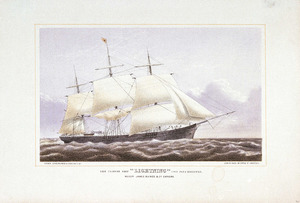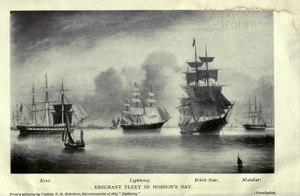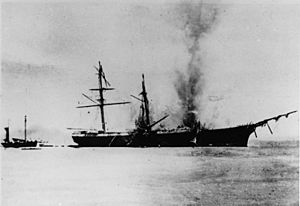Lightning (clipper) facts for kids
class="infobox " style="float: right; clear: right; width: 315px; border-spacing: 2px; text-align: left; font-size: 90%;"
| colspan="2" style="text-align: center; font-size: 90%; line-height: 1.5em;" | 
|} The Lightning was a very fast sailing ship. It was one of the last big clippers built in the United States. This amazing ship was made by Donald McKay for James Baines of the Black Ball Line. Its main job was to carry goods and people to Australia.
Some people say Lightning was the best example of a type of ship called an "extreme clipper." This means it was designed to be super fast.
Donald McKay, the builder, was famous for his ship designs. He believed in making ships that cut through the water easily. Lightning had a special front shape that helped it go fast. It was also stable and could carry a lot of sails, making it quick and steady.
Contents
| History | |
|---|---|
| Owner | James Baines & Co. |
| Ordered | 1853 |
| Builder | Donald McKay |
| Cost | £32,000 |
| Laid down |
|
| Launched | 3 January 1854 |
| Christened | 3 January 1854 |
| Acquired | British Merchant Navy |
| Commissioned | 18 February 1854 |
| Maiden voyage | 18 February – 3 March 1854 to Liverpool |
| In service | 18 February 1854 |
| Out of service | 31 October 1869 |
| Homeport | Liverpool |
| Fate | Scuttled 31 October 1869 at Geelong, Australia |
| General characteristics | |
| Class and type |
|
| Type | Clipper |
| Tonnage | 2,084 GRT |
| Tons burthen | 3.500 tons |
| Length |
|
| Beam | 44 ft (13 m) |
| Height | 164 ft (50 m) main mast (deck to truck) |
| Draught | 23 ft (7.0 m) loaded |
| Propulsion | Sails |
| Sail plan | 13,000 yards of canvas when under all plain sail |
| Speed | 19 kn (35 km/h); best 24-hour run: 436 nautical miles (807 km) in 1854 |
| Boats & landing craft carried |
6 lifeboats |
| Capacity | 1,450 tons cargo |
| Complement | 100 crew |
Ship's Journey and Records
Building a Fast Ship
Lightning was built in 1854 in Boston, USA. At this time, the demand for clippers was slowing down. However, there was a gold rush happening in Australia. So, James Baines needed ships to take passengers and cargo there. He was very impressed by the large American ships.
Lightning was built very strong to handle the rough seas on the way to Australia. Only the best materials were used to build it. The ship cost about £30,000 to make. Mr. Baines spent another £2,000 on fancy decorations inside. He added nice woods, marble, gold, and stained glass. People said its rooms were as grand as those on much later ships. There was even a newspaper on board for passengers and crew called the Lightning Gazette!
Setting Sail and Breaking Records
After Lightning arrived in England, its first captain, Anthony Enright, made a mistake. He filled in the ship's special hollow front. Donald McKay, the builder, was very upset about this. He called the people who did it "the wood butchers of Liverpool."
Later, a famous captain named James "Bully" Forbes took over. He pushed the ship to its limits. He often sailed so fast that one side of the ship was underwater! Because of this, the filler soon washed out.
Lightning then started setting amazing records. It sailed from New York to Liverpool in just 13 days and 19 and a half hours. It also traveled 436 miles in one day, going about 18 to 18 and a half knots (which is very fast for a sailing ship!). In 1854-1855, it sailed from Melbourne to Liverpool in only 65 days. This meant it went around the world in 5 months and 9 days, including 20 days spent in port.
Later Years and Final Voyage
Lightning also served a short time as a troop ship. It carried British soldiers from England to India in 87 days. They were going to help fight in the 1857 Indian Mutiny.
In 1867, a new owner named Thomas Harrison bought the ship.
On October 30, 1869, around 1 AM, Lightning caught fire in Geelong, Australia. The ship was full of cargo, including 4,300 bales of wool, 200 tons of copper, and wine. People tried to put out the fire, but they couldn't. So, around noon, they decided to sink the ship to stop the fire.
They towed Lightning to a shallow area in Corio Bay. They tried to shoot holes in its bottom with cannons from the shore, but it didn't work. Finally, around 4 PM, some of the crew cut holes in the ship's side at the water level. This made the ship sink in 27 feet of water. The shallow area where it sank is now known as "Lightning Shoals."
Images for kids






